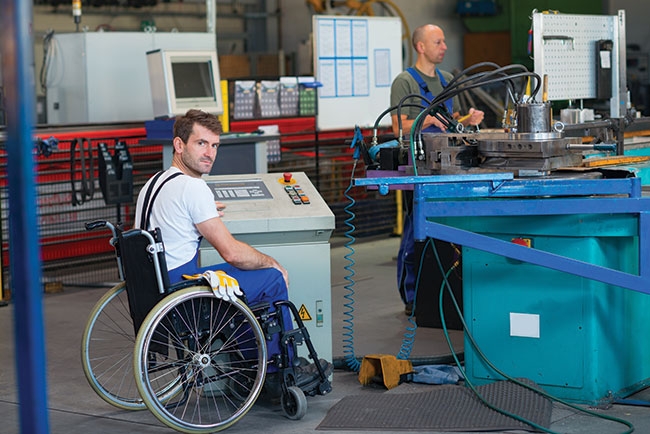
Features
Business intelligence
Contracting
Helping them work – Accommodating disability in Canada’s glass industry
Your duty to disabled workers can be more involved than you think
February 5, 2018 By Lindsey McCaffrey
 Photo: Fotolia
Photo: FotoliaAny workplace setting is bound to have at least one employee living with an injury or disability. But it doesn’t matter whether that employee’s injury or disability happened at work, at home, or somewhere in between. Employees do not have to be on worker’s compensation in order for employers to have a duty to accommodate disability.
If an employee’s injury or disability completely or somewhat prevents them from doing their job, employers have a legal duty to “accommodate” them. To get the basics on employer and employee rights and responsibilities, Glass Canada spoke with the three experts in different parts of the country: Dan Soiseth, a human rights lawyer with the Community Legal Assistance Society in B.C.; Dianna St-Pierre, an Occupational Therapist and Disability Management Consultant with Occupational Concepts in New Brunswick; and Jennifer Threndyle, an AODA specialist with Workplace Safety and Prevention Services in Ontario.
Understanding provincial and federal law
While human rights are managed through each province and territory in Canada, each provincial human rights act is based on the Canadian Charter of Rights and Freedoms. So while there may be subtle differences from province to province, similar rules generally apply when it comes to accommodating employees with an injury or disability.
Generally speaking, an injury or disability could be any temporary or permanent condition that affects a worker, including something physical (a broken arm, slipped disk, sore back, heart attack, shoulder or knee injury), something mental or emotional (depression, bipolar disorder or anxiety) or substance addiction including drugs or alcohol. It does not matter where or when the injury or disability occurred, the employer is still legally accountable to accommodate the worker. It also doesn’t matter if the disability is the worker’s fault. Whether or not the injury occurred in the workplace and whether or not you were at fault is a question for labour authorities and worker’s compensation agencies. It has no relevance to your duty to accommodate the disabled worker.
Different ways to accommodate workers
There are several ways an employer can temporarily or permanently accommodate workers who have been injured or have a disability.
Modifying the job requirements – In a manufacturing or construction environment, an employee with a strained back may not be able to lift heavy objects above a certain weight. Determining these limitations can be complicated and a matter for some discussion between medical professionals, the employee, the employer and any agencies involved but, once established, it is the employee’s legal right to be accommodated with work that does not violate those limitations.
Making changes to the work environment – Examples could include adjusting a work station, or installing a wheelchair ramp or lift.
Creating a new job – If the employee has a set of skills that could bring value to the company in some other role, the employer could create a new position for them. This is never mandated, however.
Providing training or retraining – This can help the employee do a different job, or to help them stay in a modified version of their job.
Offering a more flexible work schedule – This can address problems where an employee can do a particular job, but perhaps not for an entire shift.
No threshold, but there are limits
Of course, some employees’ needs for accommodation are greater than others. That’s where the concept of “undue hardship” comes in. Generally speaking, “The employer must endure some hardship before they are legally entitled to give up on accommodating the employee,” says Soiseth. That said, “hardship” varies, often depending on the type and size of the business.
“The test for undue hardship is ‘would accommodating the employee put the company out of business, or impact the livelihood of others?,’” Threndyle explains.
Soiseth provides an example of an employee who receives a prognosis that they will be better in 18 months. “A small manufacturing shop may not be expected to hold their original job open for them, but a larger company would likely be required to give them their job back when they’re better,” he says. “This is because larger companies generally have more opportunities available to employees and can therefore be more flexible.”
Moreover, says St-Pierre, an employer does not have to create a new job for the worker if they can prove that job brings no value to the company. The caveat is whether the worker has a set of skills that could help the business.
Proof required
To justify not accommodating an injured or disabled employee, the employer must prove they could not accommodate without experiencing undue hardship. They may be required to demonstrate such things as the amount of effort they made to try to accommodate the worker, the options they explored to find a reasonable solution for the employee, and to provide reasons why further steps are not reasonable or practical.
“The employer will need to be able to back up what they did or didn’t do,” says St-Pierre. “It can’t just be ‘We didn’t have any jobs available for them to do.’”
Moreover, if an employee does not think their employer’s accommodation is good enough, they are entitled to decline that accommodation and file a human rights complaint through the tribunal or commission in their province.
That said, adds St-Pierre, “While the employer has an obligation to accommodate an employee by respecting their abilities and restrictions, the employee also has the obligation to accept reasonable accommodation when offered, even if it is not what the employee considers the preferred
accommodation.”
Can cost less than you think
Often, it doesn’t cost a lot to accommodate. There is no hard-and-fast rule governing how much employers must pay to accommodate employees. It depends on the individual situation. However, both Threndyle and St-Pierre say that the average cost of employers accommodating employees is less than $500 across all industries. “Often, all that accommodating employees requires is providing them with a larger monitor, or a sit-and-stand desk, or raising or lowering a manufacturing belt,” says Threndyle. “Most of these things are not that expensive.”
Safety first
There are limits to accommodating employees when safety is involved. For example, there is a difference between accommodating a worker with an ongoing substance addiction and accommodating a worker who takes a substance on the job. “Ultimately, the employer needs to maintain a safe work environment for everybody,” says St-Pierre. “Whether somebody is taking a legal or illegal substance, safety is always the key thing. So accommodating someone with an addiction could mean providing a more flexible working schedule, but it doesn’t mean an employer is required to allow a drunk employee to operate heavy machinery.”
Threndyle agrees. “If a worker is a safety risk to themselves or others, they are not allowed to operate heavy equipment, work at heights or drive. Addiction is a mental health disability, but an employee cannot be under the influence and perform the duties of the job.”
Disclosure not required
What about employees who already have an injury or disability who may be applying for a physically demanding job like glass fabrication or installation? Legally, employees are not required to disclose to employers if they have a pre-existing condition, injury or disability, nor are employers allowed to ask. However, say Soiseth and St-Pierre, employers can still elicit information from applicants by focusing on job duties during the interview stage.
“It’s fair for an employer to describe the job duties and ask a job applicant if they can successfully handle the job,” says Soiseth. “Ask about training, qualifications, previous work and other experience. But keep the focus on the work to be done and the potential employee’s ability to do it, rather than on inherent disability.”
St-Pierre agrees, adding “In general, an employer is entitled to functional information: information about the person’s abilities and restrictions and safety concerns. And while you can’t ask about disabilities or diagnoses or medications, employees will often tell employers way more about themselves than is necessary. But that’s their choice.”
Threndyle recommends creating a robust job description with help from an ergonomist or other qualified professional, and asking the candidate to review, sign and date it. “Although this doesn’t secure 100 per cent protection for employers, they can put together a job description that details the physical demands of that job and have the candidate sign it, indicating they understand the terms. And if it turns out later that the candidate has misrepresented their abilities, they can be terminated. However, they may still have the right to go to their provincial human rights tribunal for discrimination based on disability,” she adds.
As for whether workers may use their “right not to disclose” for fraudulent purposes, Soiseth says employers should not generally worry. “Helping complainants with human rights cases is nearly 100 per cent of my job, and in my experience it is very, very rare for someone to get a job for the purpose of going on to workers compensation or trying to sue the employer,” says Soiseth. “That’s not to say it’s never happened, it’s just not something that employers should have on any short list of concerns when hiring.”
Good for morale, good for business
According to St-Pierre, it just makes good business sense for employers to accommodate their employees. “Think of it this way: you’re keeping an employee who has experience with the business,” she says. “If you have to replace that person completely, you’re losing everything they brought to your company in terms of experience and you’re going to have to reinvest in retraining and replacement of that employee. But ultimately, it’s just the right thing to do.”
Plus, she adds, “It has a positive effect on the overall morale of the company.”
Print this page


Leave a Reply